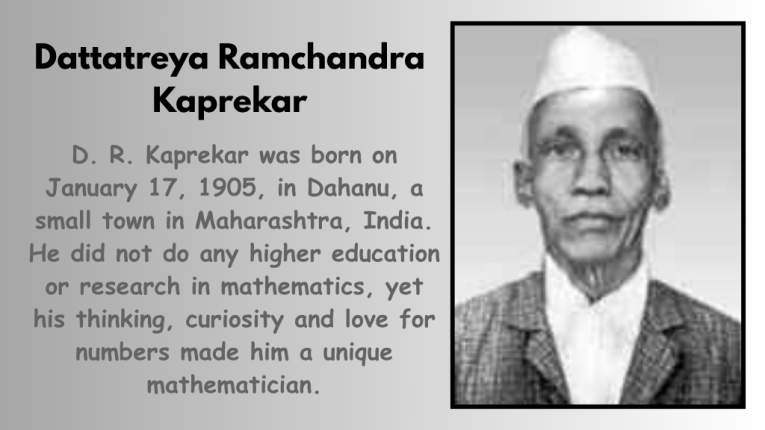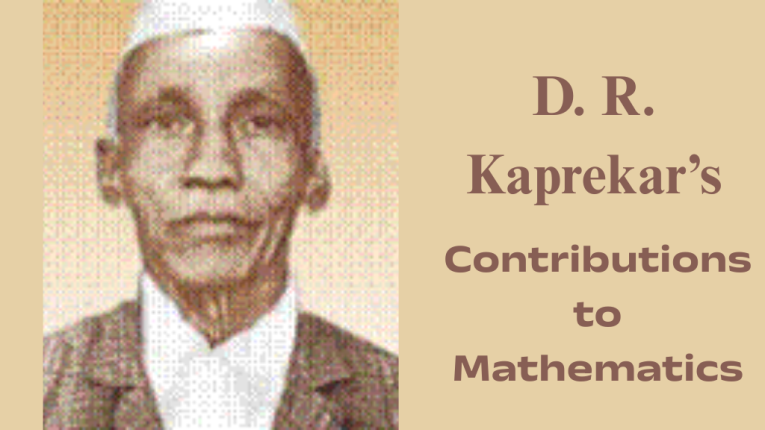Dattatreya Ramchandra Kaprekar
Dattatreya Ramchandra Kaprekar, commonly known as D.R. Kaprekar, was a famous mathematician of India. He is known for many discoveries that made mathematics fun and interesting. He is most recognized for the discovery of Kaprekar constant (6174), which is a very interesting number trick. Apart from this, he discovered many more numerical puzzles and mathematical sequences that still attract students and math lovers around the world.
D. R. Kaprekar was born on January 17, 1905, in Dahanu, a small town in Maharashtra, India. He did not do any higher education or research in mathematics, yet his thinking, curiosity and love for numbers made him a unique mathematician.
He died in the year 1986.
Kaprekar’s life is a proof of the fact that to do something new and unique, not just a degree is needed, but enthusiasm in the mind, creative thinking and hard work. Despite having limited resources, he contributed mathematical ideas that remain significant even today.
D. R. Kaprekar's Early Life and Education
D. R. Kaprekar entered the world on January 17, 1905, in the town of Dahanu, located in Maharashtra. His full name was Dattatreya Ramchandra Kaprekar. He belonged to a normal middle-class family and was interested in studies since childhood. He had a keen interest in mathematics in particular and he used to try to find some special patterns even in small numbers.
He completed his early schooling in Nashik. Later he joined the famous Ferguson College in Pune, from where he obtained a Bachelor’s (B.A.) degree in Mathematics. During his studies, he participated in various mathematics competitions and also won many prizes, which made him known as a promising mathematics student.
Although he did not have any higher research degree (PhD or Doctorate) nor did he do research work in any big institute, his deep thinking, analytical ability and fascination for numbers made him a great mathematician. The basis of his mathematical discoveries was this simple education and natural curiosity, which he developed in his youth.
His life shows that if someone has a true passion for knowledge, then despite limited resources, he can achieve extraordinary achievements.
Career and Teaching of D. R. Kaprekar
D. R. Kaprekar spent his entire life as a school teacher. He taught mathematics in a government school in the city of Deolali in Maharashtra. He never held a professorship in a major university, nor was he associated with any renowned research institute. Despite this, his dedication and love for mathematics was extraordinary.
He used to teach children in school during the day and work on his mathematical discoveries in his free time. He did not have any kind of modern technology or lab, but with only paper, pen and his ideas, he did what many big scientists could not do even with resources.
Initially, his research work did not receive much recognition at the international level, because he did not publish his articles in any well-known mathematical journal, and he did not even have any formal research degree. But with time, when he presented his work in a mathematical conference in 1949, the whole world recognized his talent.
His career teaches us that if there is genuine enthusiasm and curiosity in the mind, we can achieve great things even with limited resources. Kaprekar, despite being an ordinary teacher, became an extraordinary name in the world of mathematics.

D. R. Kaprekar’s Contributions to Mathematics: A Legacy of Number Magic
Dattatreya Ramchandra Kaprekar, fondly known as D.R. Kaprekar, may not have had formal training in advanced mathematics, but his innate genius led to the discovery of many fascinating concepts in recreational mathematics. His work focused primarily on number theory, particularly on patterns and properties of numbers that appeared simple but had profound mathematical significance.
Let us look at his 5 most important mathematical contributions that made D.R. Kaprekar a globally recognized name:
1. Kaprekar Constant (6174): The Magical Number
Kaprekar constant, also known as 6174, is one of the most famous discoveries of D.R. Kaprekar. This is a number that seems like a game of numbers and is very interesting. Let’s understand it in simple language.
How does this number work?
First of all, take any four-digit number. But keep in mind that all its digits should not be the same.
Example: 3524
Now arrange its digits from largest to smallest and then from smallest to largest:
- Largest to smallest = 5432
- Largest to largest = 2345
Subtract the smaller value from the larger to get the result.
- 5432 – 2345 = 3087
Repeat the process again using the new number, 3087:
- 8730 – 0378 = 8352
- 8532 – 2358 = 6174
Now listen to the amazing thing:
If you do this process with any four-digit number (where all the digits are different), you will always end up with 6174 — and that too in just 7 or less times!
Once you reach 6174, no matter how many times you repeat this process, the answer will always be 6174:
- 6174 – 4761 = 6174
This is why it is called the Kaprekar constant. It is also called “Kaprekar’s Routine”.
What is so special about it?
This discovery reveals the surprising order and elegance hidden within numbers. It’s not just an entertaining puzzle for children—mathematicians, too, have been fascinated by its brilliance.
2. Self-Numbers (Kaprekar Numbers)
In 1949, D.R. Kaprekar made a unique and interesting discovery of Self Numbers. These are also called Kaprekar numbers.
What is Self Number?
A Self Number is one that cannot be formed by adding the sum of the digits of any other number to itself.
In simple language:
Any number that we cannot obtain by adding the digits of another number is called a Self Number.
Example:
Suppose we have the number 20.
Now think — is there any number that when added to the sum of its digits gives 20?
For example:
→ 15 + (1 + 5) = 21
→ 14 + (1 + 4) = 19
→ 13 + (1 + 3) = 17
→ And no such number makes 20.
So, 20 is a Self-Number.
Why is this discovery special?
The idea of self-number is very interesting and is still popular among math lovers, students, and puzzle solvers. It also helps in the study of number theory.
3. Harshad Numbers
Another interesting discovery of D.R. Kaprekar was Harshad numbers.
‘Harshad’ is a word from Sanskrit that means ‘a number that brings happiness or joy’
What is Harshad number?
Harshad number is one which is exactly divisible by the sum of its digits.
Easy example:
- Suppose we have a number 18.
- Sum of its digits = 1 + 8 = 9
- Now see: 18 ÷ 9 = 2, i.e. exactly divisible.
So, 18 is a Harshad number.
More examples:
- 21 → 2 + 1 = 3 → 21 ÷ 3 = 7 → Harshad number
- 25 → 2 + 5 = 7 → 25 ÷ 7 = 3.57 → Not a Harshad number
Why is it special?
Harshad numbers help in understanding the rules of divisibility in mathematics.
They are also an important part of recreational mathematics and number theory.
4. Kaprekar’s Process for Square Numbers
D.R. Kaprekar discovered a very interesting and fun trick in mathematics. He observed that if the result of squaring some numbers is divided into two parts and then both the parts are added, then the same original number is obtained.
Let us understand with an example:
Suppose you square 45:
- 45² = 2025
Now divide this 2025 into two parts – 20 and 25
Then 20 + 25 = 45 (which was our starting number)
In other words, when 45 is squared and its result split into two parts, their sum magically brings you back to 45.
This is not magic, but a brilliant mathematical trick called Kaprekar’s square number trick.
This kind of trick works on many other numbers as well, and hence it is very popular in schools, math competitions and number related games.
5. Digit-Based Mathematical Curiosities
D.R. Kaprekar had a deep love for mathematics. He used to play with numbers for hours and discover the hidden patterns and mysteries in them. This passion of his is clearly visible in the many fun and unique numbers he discovered.
Some of his special areas of study:
Repetitive numbers:
That is, numbers in which the same digit appears again and again, such as – 11, 111, 1111 etc.
He also discovered interesting mathematical properties in these numbers.
Palindromic numbers:
Numbers that are the same when read from both sides, such as – 121, 1331.
He also discovered many beautiful patterns in these numbers.
Other interesting numbers:
He discovered many more special numbers and number-based puzzles, which even today attract mathematics lovers and students a lot.
He did a great job without any help
Kaprekar neither had the support of big institutions nor access to famous journals, yet he prepared his own notes and booklets. His aim was to make mathematics so interesting that people would start enjoying it instead of being afraid of it.
His approach proves even today that with pure dedication and creative thinking; any great work can be done – even if you have limited resources.

Recognition and Legacy of D. R. Kaprekar
For many years, D. R. Kaprekar’s contributions initially went unnoticed in the mainstream mathematical community. His discoveries were not taken seriously at first. But when he shared his research and information about numbers during a mathematics conference in Mumbai in 1949, many mathematicians became interested in his work.
Today:
- D.R. Kaprekar is considered one of the great mathematicians of India.
- His discoveries have become a part of many important things related to number theory.
- His name is now taught in school textbooks, competitive examinations and math competitions.
- He taught that there can be play, beauty and pattern in numbers too – and this is what inspires people to take interest in mathematics even today.
D. R. Kaprekar Biography Summary
- Full Name: Dattatreya Ramchandra Kaprekar
- Famous For: Kaprekar constant, self-numbers, Harshad numbers
- Profession: School teacher and mathematician
- Nationality: Indian
- Specialization: Recreational mathematics
Interesting Facts about D. R. Kaprekar
- Kaprekar published most of his work in the Journal of Recreational Mathematics.
- He had no formal research background, yet he became globally renowned for his discoveries.
- He was often called the “magician of numbers”.

Frequently Asked Questions (FAQs)
Ques 1: What is D. R. Kaprekar known for?
Ans: He is best known for the Kaprekar constant (6174), self-numbers and Harshad numbers.
Ques 2: What are the birth and death dates of D. R. Kaprekar?
Ans: He was born on 17 January 1905 and died in 1986.
Ques 3: Where did D. R. Kaprekar study?
Ans: He studied at Ferguson College in Pune, India.
Ques 4: What are D. R. Kaprekar’s contributions to mathematics?
Ans: He discovered the Kaprekar constant, introduced the concept of self-numbers, explored Harshad numbers, and worked on various digit-based number puzzles.
Ques 5: Is D. R. Kaprekar considered a famous Indian mathematician?
Ans. Yes, D. R. Kaprekar is regarded as one of the most renowned Indian mathematicians known for his work in recreational mathematics.
Final Thoughts
D. R. Kaprekar’s legacy reminds us that true genius often lies in simplicity. His mathematical contributions with minimal resources and beyond traditional academia prove that passion and curiosity can lead to timeless discoveries. Whether you are a student or a math enthusiast, exploring the life and work of Dattatreya Ramachandra Kaprekar will not only inspire but also awaken a deep appreciation for the beauty of numbers.

